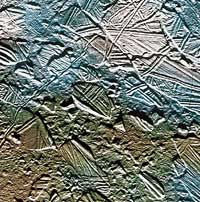World Book at NASA
 |
|
The surface of Europa, a moon of Jupiter, consists mostly of huge blocks of ice that have cracked and shifted about, suggesting that there may be an ocean of liquid water underneath. Image credit: NASA |
Europa, (yu ROH puh), is a large moon of Jupiter. Its surface is made of ice, which may have an ocean of water beneath it. Such an ocean could provide a home for living things. The surface layer of ice or ice and water is 50 to 100 miles (80 to 160 kilometers) deep. The satellite has an extremely thin atmosphere. Electrically charged particles from Jupiter's radiation belts continuously bombard Europa.
Europa is one of the smoothest bodies in the solar system. Its surface features include shallow cracks, valleys, ridges, pits, blisters, and icy flows. None of them extend more than a few hundred yards or meters upward or downward. In some places, huge sections of the surface have split apart and separated. The surface of Europa has few impact craters (pits caused by collisions with asteroids or comets). The splitting and shifting of the surface and disruptions from below have destroyed most of the old craters.
Europa's interior is hotter than its surface. This internal heat comes from the gravitational forces of Jupiter and Jupiter's other large satellites, which pull Europa's interior in different directions. As a result, the interior flexes, producing heat in a process known as tidal heating. The core of Europa may be rich in iron, but most of the satellite is made of rock.
Europa's diameter is 1,940 miles (3,122 kilometers), slightly smaller than Earth's moon. Europa takes
3.55 days to orbit Jupiter at a distance of 416,900 miles (670,900 kilometers). The Italian astronomer
Galileo discovered Europa in 1610. Much of what is known about it comes from data gathered by a space
probe, also named Galileo, that orbited Jupiter from 1995 to 2003.
Contributor: William B. McKinnon, Ph.D., Professor of Earth and Planetary Sciences,
Washington University.
How to cite this article: To cite this article, World Book recommends the following format: McKinnon,
William B. "Europa." World Book Online Reference Center. 2004. World Book, Inc.
http://www.worldbookonline.com/wb/Article?id=ar186650.
| › Return to Topics | › Back to Top |